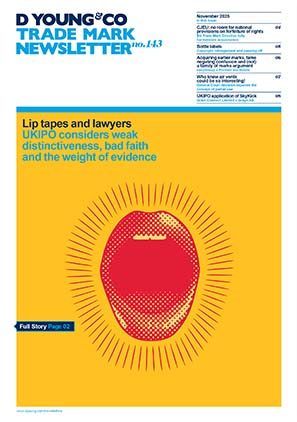Inherent distinctiveness and signs depicting products: norms and customs test insufficient in itself
This ex partes decision concerns the refusal of a figurative trade mark depicting a product (the lid of a lip mask), namely (UK) international registration no.WO0000001789520 (see below) filed in relation to goods such as lip balm and cosmetics (the application). The application was refused on the basis that it lacked distinctive character, in contravention of section 5(2)(b) of the Trade Marks Act 1994.

Following the initial refusal, the applicant requested a hearing, whereby it was argued that the mark departed significantly from the norms and customs of the lip balm and cosmetic sector (the norms and customs test). However, the refusal was maintained. This case, which sets out the registrar’s reasons for the decision, provides useful guidance on the assessment of inherent distinctiveness in relation to trade marks depicting products or their packaging. Key points include:
The assessment criteria and the norms and customs test
The hearing officer set out various established principles related to the assessment of inherent distinctiveness in relation to marks depicting the appearance of a product, including various Court of Justice of the European Union (CJEU) decisions (such as Henkel KGaA v OHIM; Case C-144/06 P).
In summary, the case law provides that the criteria for assessing distinctiveness is no different to any other category of mark. However, account must be taken of the fact that consumers are not in the habit of making assumptions about the origin of products on the basis of their shape or packaging. In such circumstances, “only a mark which departs significantly from the norm or customs of the sector and thereby fulfils its essential function of indicating origin is not devoid of any distinctive character”: the norms and customs test.
In the UK, the norms and customs test has been found ([2017] EWCA Civ 1729, London Taxi) to have three steps:
- A determination of what the sector is.
- The identification of the norms and customs, if any, within that sector.
- A decision as to whether or not the mark departs significantly from those norms and customs.
Is the norms and customs test a sufficient test: CJEU jurisprudence not “acte Claire”
In the decision, the hearing officer noted that whilst CJEU jurisprudence may be saying that the norms and customs test is the only necessary test to establish distinctiveness, the UK courts do not regard the jurisprudence of the CJEU as being acte claire, despite it being assimilated law.
According to the hearing officer, “whilst the UK Courts seem to acknowledge that the question of ‘departing significantly from the norms and customs’ is a necessary test, they do not appear to agree that it is also a ‘sufficient’ test.”
The approach taken: additional step required
The hearing officer considered that whilst the norms and customs test is necessary, there still must be (a seemingly separate) consideration as to whether the mark is distinctive.
The hearing officer noted from case law (Robinson’s Squash Bottle decision (BL o-263-18) and Yakult [2001] RPC 39) and Kerly (a leading trade mark law text ) a difference between the concept of distinctiveness per se (that is the ability to stand out in a general sense) and distinctiveness in a trade mark sense (that is to denote trade origin). In line with these authorities, the hearing officer stated that simply being novel, eye-catching or standing out is insufficient.
Consequently, in illustrating the inherent distinctiveness of a sign depicting a product, as well as satisfying the norms and customs test, it seems that the Registry must also be satisfied that the mark is distinctive in a trade mark sense.
Application to the facts
In applying these principles, it was found that whilst the application did significantly depart from the norms and customs of the trade in the cosmetic sector, the application was nevertheless non-distinctive.
The hearing officer stated “The final test is a statutory one, ‘is the sign devoid of distinctive character’, not whether the shape happens to be novel or original or even distinctive in a purely general sense.”
Consequently, it was found that whilst the average consumer would view the shape as an aesthetically pleasing, they would be unlikely to perceive it as a trade mark.
In short
This Registry decision sets out a seemingly high burden to establish inherent distinctive character in trade marks that depict the appearance of a product. On the basis of this decision, it seems likely that applicants will struggle to achieve trade mark registrations for signs depicting products without providing evidence of acquired distinctive character or including additional distinctive elements.
Case details at a glance
Jurisdiction: England & Wales
Decision level: UKIPO
Parties: HAVE&BE Co Ltd
Citation: O/0042/25
Date: 16 January 2025
Decision (PDF): dycip.com/UKIPO-o004225

